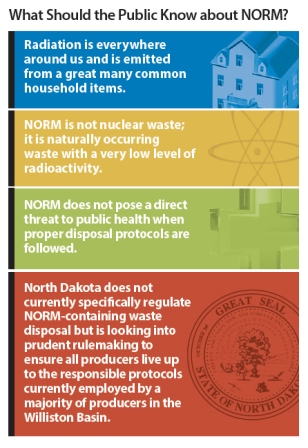NORM waste has received increasing levels of attention during the rapid increase in Bakken oil and gas activity. NORM is a new term to many. The Energy & Environmental Research Center (EERC) is working to apply science to rules being developed by the state of North Dakota to regulate the disposal of this natural waste in a manner that protects public health yet does not stifle industrial activities.
What Is NORM?
NORM is present throughout Earth’s crust and can be concentrated by processes associated with the recovery of oil and gas. Also referred to as technologically enhanced NORM (TENORM), this material can be concentrated in oil production wastes such as sludge, drilling mud, used water filtration sleeves, and pipe scale. TENORM radioactivity levels tend to be highest in water-handling equipment.
Some Radiation Fundamentals
Radiation is energy emitted by matter in the form of rays or high-speed particles. Radiation is all around us. There is a natural background radiation level throughout the universe. Radioactive materials in Earth’s crust also contribute to terrestrial background radiation.
Radiation is either ionizing or nonionizing, depending on how it affects matter. Nonionizing radiation (light, heat, radio waves) transfers energy to materials through which it passes but does not break molecular bonds. Ionizing radiation (x-rays, gamma rays, high-energy particles) cuts bonds that hold molecules together, thus leaving molecular pieces, known as ions, in its wake. These ions may cause changes in living tissues or may change the physical properties of nonliving materials.
Radiation measurement is a confusing mix of terms and concepts. Radiation levels are measured in terms of total activity (emitted from source material), dosage (radiation absorbed), or exposure (e.g., millisievert [mSv]). Although dosage is often the most meaningful in public health discussions, most state rulings on NORM disposal regulate levels of radioactivity per unit weight.
What Level of Radioactivity Is Hazardous?
To understand how much radiation is dangerous, we need to focus on equivalent dose numbers. Equivalent dosages accumulate over time of exposure, so intensity and duration are equal factors. More of either increases the risk of adverse health effects. A nuclear reactor core may trap huge amounts of total radioactivity, but because of engineered shielding between the reactor core and personnel operating the nuclear power plant, the personnel do not absorb hazardous levels of radioactivity. When the personnel must enter a zone of higher radioactivity, their exposure time is strictly limited. Comparing radioactivity with equivalent doses is like comparing apples and oranges.
Generally speaking, TENORM must be inhaled or ingested to pose a radiation health risk. This is because a vast majority of radiation emitted from TENORM is in the form of alpha particles, easily stopped by the outer layers of human skin. Because these wastes are typically landfilled or otherwise buried, there is little risk from external exposure.
How Is NORM Regulated?
Wastes containing NORM are not regulated by federal agencies. Instead, it has been left to states to regulate handling of NORM. Currently, 15 states specifically regulate NORM, while other states more generally regulate radioactive wastes. Of course, the language of these NORM regulations varies, but many states have similar regulations limiting disposal of NORM-containing waste in municipal landfills to less than 5 picoCuries/gram (pCi/g) above the normal background level of 226Ra or 228Ra, two radioactive isotopes of radium that can be found in oilfield wastes. The table below suggests a comparison between common landfill wastes and their radioactivity levels against this common NORM rule. It is not suggested that these wastes fall under NORM disposal rules, but it does present an interesting comparison.
How Is NORM Disposed Of?
Disposal protocols differ greatly across states and across oil and gas producers. Generally, NORM-contaminated equipment is tagged, sent to a decontamination service, decontaminated, and then shipped to a landfill. Alternately, some companies opt to send low-level contaminated material directly to licensed NORM disposal sites, often out of state. Occasionally, companies unwittingly transport NORM-contaminated waste to local landfills not approved to accept this waste. Most oil patch landfills have their own radioactivity-monitoring protocol in place to prevent this.
This, of course, leads naturally to the question of what threshold of radioactivity defines "NORM contamination" in the first place? Here is where science is currently working to provide answers. The oft-employed 5-pCi/g rule is extremely conservative in the estimation of many. Work is ongoing to determine an appropriate threshold.




